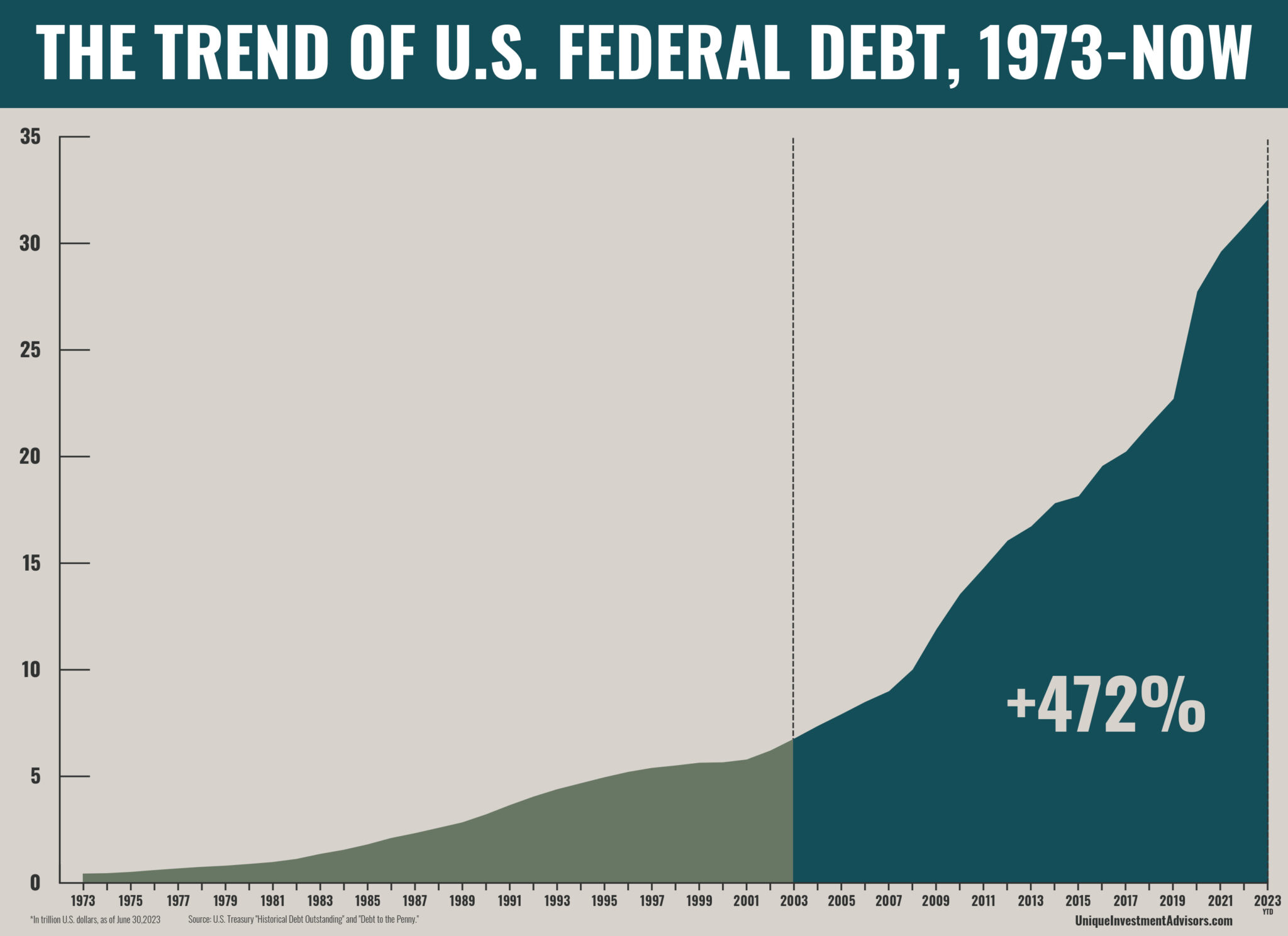US Official National Debt
Debt Clock Per Person (US Citizen) Loading...
* Based on current US population, not per US taxpayer.

Over 25 Trillion "Official" Rise in 20 Years (+472% Increase)
In our opinion the United States has experienced a significant and rapid increase in national debt in just the past 20 years. Over this period, the national debt has soared over 25 trillion dollars, amounting to an astonishing 472% increase.* There have been a number of factors contributing to its growth up to these unprecedented levels.
One of the primary drivers of the mounting federal debt has been the increased government spending. In response to various economic challenges, such as the nancial crisis of 2008 and subsequent recessions, the government implemented substantial stimulus packages and increased funding for social programs. These measures aimed to stabilize the economy and support citizens during dif cult times, but they also contributed to the accumulation of debt. Additionally, rising healthcare costs, increased defense spending, and a growing interest on the debt itself have further exacerbated the situation.
Another factor in uencing the rapid increase in the current national debt is the revenue side of the equation. While the government has implemented tax policies and generated revenue through other means, it has struggled to keep up with the rising expenditures. Additionally, demographic changes, such as the retirement of the baby boomer generation, have put pressure on social security and Medicare programs, straining the budget even further.
As a consequence of this unsustainable path in federal debt, concerns have been raised about its long-term implications. The burden of servicing the debt and the potential impact on future generations are subjects of ongoing debates. Efforts to address the issue have included discussions on scal responsibility, budget reforms, and revenue enhancement. However, having a balanced solution that ensures economic stability and sustainable debt management remains a complex and challenging task for policymakers.
*U.S. Treasury “Historic Debt Outstanding.”
“Blessed are the young for they shall inherit the national debt.”
— Herbert Hoover
Official National Reported Debt VS. Actual "Real" Debt
UNDERSTANDING THE DIFFERENCE
The reported “official” national debt and the actual “real” debt differ a great deal, leading to confusion and concerns among the general public. Understanding the differences between these two figures is crucial for grasping the true extent of a country’s debt burden.
The published “official” national debt is a figure provided by the government, typically based on the amount of money borrowed to finance government spending. It includes the outstanding debt held by the public, such as treasury bonds, as well as intra-governmental debt, which represents funds borrowed from other government agencies. This figure is widely reported and serves as a standard measure of a country’s debt.
On the other hand, the actual total US national debt takes into account additional obligations and liabilities that may not be included in the reported figure. These can include unfunded liabilities like future pension obligations, healthcare commitments, and social security payments. These long-term obligations can significantly impact a country’s financial health, but are often not factored into the official debt numbers.
The difference between the reported and actual debt can arise due to various factors. Governments may choose not to disclose certain liabilities, or they may use accounting techniques to downplay the true extent of their financial obligations. Political considerations, short-term objectives, and a desire to maintain confidence in the economy can all influence the reporting of national debt.
It is essential to consider both the reported and real debt figures to obtain a comprehensive understanding of a country’s financial situation. While the reported figure provides a snapshot of the debt borrowed thus far, the actual debt accounts for future obligations that can have substantial implications for future generations.
By recognizing the disparities between the published and real debt, policymakers and citizens can make more informed decisions and engage in productive discussions regarding fiscal responsibility and long-term sustainability. Transparency and accurate reporting are vital for ensuring the effective management of a nation’s finances and the overall economic well-being of its citizens.
The real versus reported federal debt numbers for the United States are rather troublesome:
The “True” National Debt: $157,205,275,638,000 6/19/23
Each Taxpayers Share: $939,000 6/19/23
Truth in Accounting https://www.truthinaccounting.org/
The United States "Official" Reported National Debt consists of:
- Debt owned by the general populace
-
Holdings of different branches of government, such as debt held by the Social Security Administrations and Medicare trust funds.
These are not inclusive of total unfunded U.S. Social Security, Medicare, and other debt obligations.
The "Truth" includes:
- Assets and liabilities reported in the Financial Report of the U.S. Government
- Unfunded Social Security, Pension, Medicare, and other commitments, based on assumptions.
“Rather go to bed without dinner than rise on debt.”
— Benjamin Franklin
Looking for a Unique Investment Firm?
Let us know how we can help.















